
Oceania is a geographic region that includes Australasia, Melanesia, Micronesia and Polynesia. Spanning the Eastern and Western Hemispheres, Oceania has a land area of 8,525,989 square kilometres (3,291,903 sq mi) and a population of over 41 million. When compared with the continents, the region of Oceania is the smallest in land area and the second smallest in population after Antarctica.

Ipomoea is the largest genus in the flowering plant family Convolvulaceae, with over 600 species. It is a large and diverse group, with common names including morning glory, water convolvulus or kangkung, sweet potato, bindweed, moonflower, etc.

The blue maomao, also known as the violet sweep, blue sweep or hardbelly, is a species of marine ray-finned fish, a member of the subfamily Scorpidinae, part of the sea chub family Kyphosidae. It is native to the southwestern Pacific Ocean from Australia to New Zealand and the Kermadec Islands, where it can be found in inshore waters from the surface to depths of 30 m (98 ft). This fish can reach a length of 40 cm (16 in). It is commercially important and is also a popular game fish.
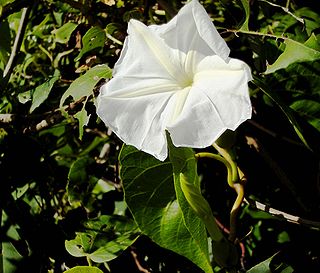
Ipomoea violacea is a perennial species of Ipomoea that occurs throughout the world with the exception of the European continent. It is most commonly called beach moonflower or sea moonflower as the flowers open at night.

Banksia violacea, commonly known as violet banksia, is a species of shrub or tree in the plant genus Banksia. It generally grows as a small shrub to 1.5 m (5 ft) high with fine narrow leaves, and is best known for its unusually coloured dark purple-violet inflorescences. The colour of the inflorescences, short leaves, and flattened follicles which are sticky when young, help identify this species from others in the field. It is found in low shrubland in southern regions of Western Australia from Esperance in the east to Narrogin in the west, growing exclusively in sandy soils.

The pelagic stingray is a species of stingray in the family Dasyatidae, and the sole member of its genus. It is characterized by the wedge-like shape of its pectoral fin disc, which is much wider than long, as well as by the pointed teeth in both sexes, whip-like tail with extremely long tail spine, and uniform violet to blue-green coloration. It generally reaches 59 cm (23 in) in width. The pelagic stingray has a worldwide distribution in waters warmer than 19 °C (66 °F), and migrates seasonally to spend the summer closer to the continental shelf and at higher latitudes. The only stingray that almost exclusively inhabits the open ocean, this species is typically found in surface waters down to a depth of 100 m (330 ft). As a consequence of its midwater habits, its swimming style has evolved to feature more of a flapping motion of the pectoral fins, as opposed to the disc margin undulations used by other, bottom-dwelling stingrays.
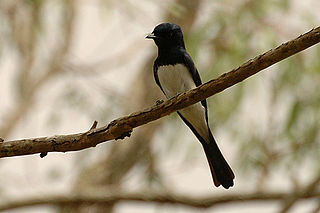
The satin flycatcher is a species of bird in the family Monarchidae. Males stand out with their blue-black feathers contrasting their white bellies, and the females with their bright orange throats. It breeds mostly in south-eastern Tasmania and Australia. It is declining throughout the eastern seaboard due to predation from the introduced Red Fox and habitat loss. It is a vagrant to New Zealand.
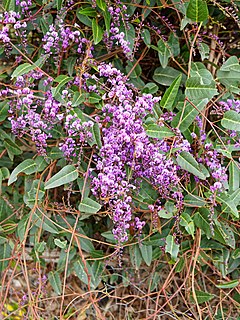
Hardenbergia violacea is a species of flowering plant in the family Fabaceae and is endemic to Australia. It is known in Australia by the common names false sarsaparilla, purple coral pea and waraburra. Elsewhere it is also called purple twining-pea, vine-lilac and wild sarsaparilla. It is a prostrate or climbing subshrub with egg-shaped to narrow lance-shaped leaves and racemes of mostly purple flowers.
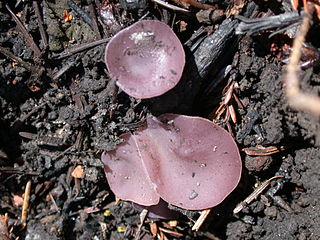
Peziza violacea, commonly known as the violet fairy cup or the violet cup fungus, is a species of fungus in the genus Peziza of the family Pezizaceae. As both it common names and specific epithet suggest, the cup-shaped fruiting bodies are violet colored on the interior surface. P. violacea is typically found growing on burnt soil.
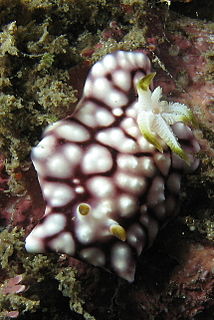
Goniobranchus geometricus is a species of colourful sea slug, a dorid nudibranch, a marine gastropod mollusc in the family Chromodorididae.
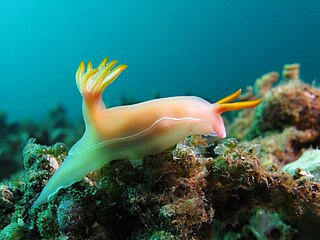
Hypselodoris bullockii is a species of colourful sea slug or dorid nudibranch, a marine gastropod mollusc in the family Chromodorididae.

Phalaenopsis violacea is a species of orchid endemic to the Andaman Islands, the Nicobar Islands and northwestern Sumatra.

Tectonatica violacea, common name the violet moon snail, is a species of predatory sea snail, a marine gastropod mollusk in the family Naticidae, the moon snails.

Zinnia elegans known as youth-and-age, common zinnia or elegant zinnia, is an annual flowering plant in the daisy family Asteraceae. It is native to Mexico but grown as an ornamental in many places and naturalised in several places, including scattered locations in South and Central America, the West Indies, the United States, Australia, and Italy.

Diazona violacea is a species of tunicate, an ascidian in the family Diazonidae. It is the type species of the genus Diazona.
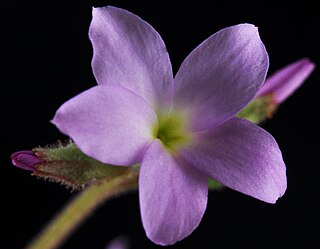
Suksdorfia violacea is an uncommon species of herbaceous flowering plant in the saxifrage family known by the common name violet suksdorfia. In 1879 Asa Gray named the genus Suksdorfia after Wilhelm Nikolaus Suksdorf who had first collected a specimen of S. violacea in 1878 near Mount Adams-White Salmon, Washington and sent it to Gray for assistance in classifying it. Gray and Suksdorf had a long and close working relationship, and Gray initially identified and named various species found by Suksdorf. Its conservation status has been rated by NatureServe as "G4 – Apparently Secure".

Myripristis violacea is a species of fish in the family Holocentridae found in the Indo-Pacific Ocean
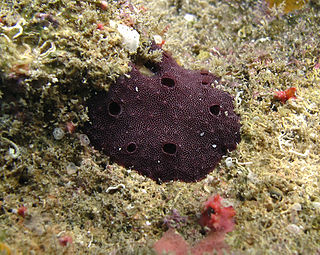
Chelonaplysilla is a genus of sponges in the family Darwinellidae.
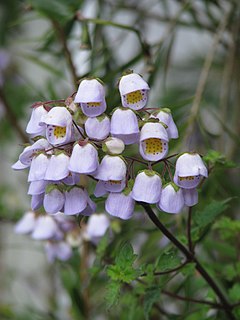
Jovellana violacea, also known as the violet teacup flower or violet slipper flower, is a perennial species of flowering plant in the family Calceolariaceae. It is native to Chile.

Phalaenopsis mentawaiensis is a species of orchid endemic to Sumatra, Indonesia. The specific epithet mentawaiensis refers to the Mentawai islands of West Sumatra.




















